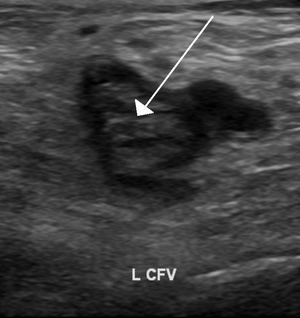Hypercoagulability
| Thrombophilia | |
|---|---|
 |
|
| An ultrasound image demonstrating a blood clot in the left common femoral vein. | |
| Classification and external resources | |
| Specialty | hematology |
| ICD-10 | D68.5-D68.6 |
| ICD-9-CM | 286.9 |
| OMIM | 188050 |
| DiseasesDB | 29080 |
| eMedicine | article/211039 |
| Patient UK | Thrombophilia |
| MeSH | D019851 |
Thrombophilia (sometimes hypercoagulability or a prothrombotic state) is an abnormality of blood coagulation that increases the risk of thrombosis (blood clots in blood vessels). Such abnormalities can be identified in 50% of people who have an episode of thrombosis (such as deep vein thrombosis in the leg) that was not provoked by other causes. A significant proportion of the population has a detectable abnormality, but most of these only develop thrombosis in the presence of an additional risk factor.
There is no specific treatment for most thrombophilias, but recurrent episodes of thrombosis may be an indication for long-term preventative anticoagulation. The first major form of thrombophilia, antithrombin deficiency, was identified in 1965, while the most common abnormalities (including factor V Leiden) were described in the 1990s.
The most common conditions associated with thrombophilia are deep vein thrombosis (DVT) and pulmonary embolism (PE), which are referred to collectively as venous thromboembolism (VTE). DVT usually occurs in the legs, and is characterized by pain, swelling and redness of the limb. It may lead to long-term swelling and heaviness due to damage to valves in the veins. The clot may also break off and migrate (embolize) to arteries in the lungs. Depending on the size and the location of the clot, this may lead to sudden-onset shortness of breath, chest pain, palpitations and may be complicated by collapse, shock and cardiac arrest.
Venous thrombosis may also occur in more unusual places: in the veins of the brain, liver (portal vein thrombosis and hepatic vein thrombosis), , kidney (renal vein thrombosis) and the veins of the arms. Whether thrombophilia also increases the risk of arterial thrombosis (which is the underlying cause of heart attacks and strokes) is less well established.
...
Wikipedia
